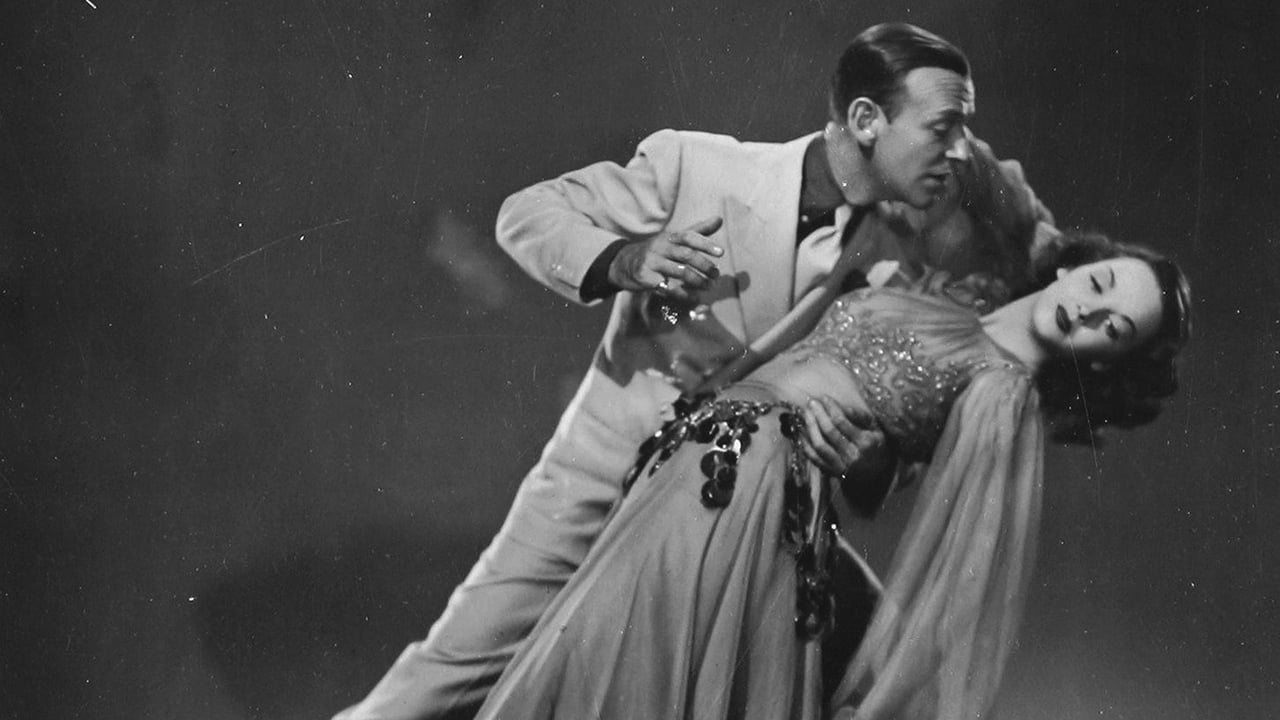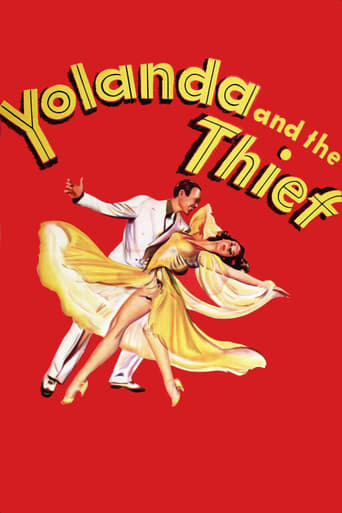

When Yolanda and the Thief is good it is great, but when it is not so good it does significantly underwhelm, a case of having a lot of style and not enough substance. Like The Belle of New York, Yolanda and the Thief is one of Astaire's weakest films, but has a number of virtues that is enough for one to stick with it.Yolanda and the Thief does look glorious, with positively exotic colours, lavish cinematography and opulent costumes. In this regard, the best and most interesting scene visually is the dream sequence, which looks really stunning. The songs are not enough and they are not the most memorable in the world, but they are pleasant and fun and don't drag the film down too much, the best song being the riotous Coffee Time.Vincente Minnelli directs very imaginatively, his sense for storytelling has been much stronger in his other films but in terms of style and visual imagination he triumphs. Choreographically, Yolanda and the Thief dazzles as much as the visuals, especially in the dream sequence, which is very colourfully and elegantly choreographed and superbly danced, and Coffee Time, which has the most energy the film ever gets. Fred Astaire is in a different role to usual(very like Three Little Words, except his performance is better in that) and while it does seem like an ill fit at first, he plays it with real grace, suavity and charm while his dancing is magnificent as always. Lucille Bremer proves herself one of his most elegant partners and she dances exquisitely, while Mildred Natwick has fun as the Aunt.The story however struggles to sustain the running time, is very predictable even for a 40s musical and strains credibility quite badly. The opening sequence is unnecessary and clumsily handled and the ending felt abrupt and under-explained. The script manages to be even thinner and the attempts at humour are leaden and unfunny, while the film shamefully wastes Frank Morgan and Leon Ames, two very reliable actors when with good material but their roles here do nothing for their talents at all. Outside of the musical numbers the film also struggles maintaining momentum, and while her dancing is delightful Bremer seemed very overtaxed and cold in her acting.All in all, one of Astaire's weakest but has enough to partially recommend it. 6/10 Bethany Cox
... View MoreIt's a given that the best musicals, be they stage or screen, feature the best music, best lyrics and best books; think of (to confine ourselves to movies) Meet Me In St Louis, A Star Is Born (Garland version), Young At Heart, High Society. All with strong books, flesh-and-blood characters, great music, great lyrics. It's possible to get away with one weak element, usually the book, again think of the Astaire-Rogers series, barely a credible book between the lot of them but more than redeemed by the scores and, of course, the dancing. Astaire fared badly also with the book of Royal Wedding but again the score cancelled it out but when you have a weak book, weak music and weak lyrics - think Astaire in Second Chorus - then you don't even have a weak prayer. Yolanda And The Thief is weak in all three departments. Arthur Freed was arguably the worst lyricist Harry Warren was ever saddled with. But hold it a minute, isn't that the SAME Arthur Freed who produced all those classic MGM Musicals and ran, in fact, the Freed Unit? You got it in one; Freed is like the only boy on the block who owns a cricket bat, ball and set of stumps so even though not terribly gifted either he gets to play or no one does. To be fair to Freed he'd just worked with Warren on This Heart Of Mine heard in Ziegfeld Follies - this was Astaire's first MGM movie and actually shot before Yolanda though released after - and turned in a serviceable lyric albeit far inferior to Warren's melody but here he seems to be anticipating the 'modern' musicals that make a virtue out of dreary, uninspired lyrics. The book is a joke and somehow Minnelli and Freed combine to make even Astaire's dancing seem pedestrian. What id did have (apparently) was lavish colour, hardly surprising given Minnelli's penchant for colour but the print I saw was washed out so I'll have to take it on trust. I'm glad I saw it but I'd pay good money to see Astaire in The Passing Of The Third Floor Back.
... View MoreIt's impossible to hate any film with Fred Astaire, Frank Morgan and Mildred Natwick giving their considerable all, but it's awfully hard to like any film with such forgettable songs (out of Harry Warren's bottom drawer), forgettable dances inspired by them from choreographer Eugene Loring (except for the promising percussive *introduction* to an ultimately dreary number called "Coffee Time") and a script that never pays off on a single one of its satiric possibilities.At it's best, the old "studio system" of production by second guessing and committee could produce masterpieces. At its muddled worst, it produced things like YOLANDA AND THE THIEF and blamed them on the cast. Coming at about the middle of Fred Astaire's long film career, and early in Lucille Bremer's four year one, it couldn't ultimately hurt Astaire who would be back on top in three years with EASTER PARADE (interesting that his brief "retirement" in response to this turkey is not remembered in the same way Bette Davis's similarly motivated walkout from another studio is for his being "difficult"), but it did nothing to promote Bremer's career despite what looked like acceptable dancing and at least minimal acting skills and a certain homogenized beauty.Chief blame would appear to lie with Irving Brecher's script from Ludwig Bemelmans & Jacques Thery's nasty little fairy tale of a story. Trading on the worst stereotypes of the evils of a Convent education (not that a too sheltered education isn't a bad thing), Bremer's "Yolanda" is too naive to be believed and a victim looking for a crime. Only those ALMOST as naive in the audience will not recognize Leon Ames's "Mr. Candle" character immediately for what he turns out to be, and the simple (even expected) plot twists which could make his character and Mildred Natwick's "Aunt Amarilla" interesting are never forthcoming. Only Natwick's self centered monologue when Bremer returns to her home from the convent rises above the rest of the script and is very funny - creating hopes for what follows that never pay off. The final scene of the film is so perfunctory you get the impression the studio told Minnelli to wrap up filming regardless of what was left to do - but fans of the British sci-fi sitcom "Red Dwarf" may be amused to note that the central gimmick of the scene (and the film's only moment of misdirection or real irony) was stolen years later as the basis for a Red Dwarf episode in its first season.Among things which ARE of interest in the film: the man who went on to become the great Broadway dancer and choreographer, Matt Mattox, is buried somewhere in the innocuous mess as an unbilled "featured dancer." One wonders if the (uncredited) "Dilettante" played by an actor calling himself "Andre Charlot" is any relation to the great British producer who introduced Gertrude Lawrence and Beatrice Lillie to U.S. shores for the first time in the 1920's?
... View MoreIf Yolanda and the Thief isn't the damnedest thing ever committed to film, it's hard to say what is. Vincente Minnelli took a wisp of whimsey from Ludwig Bemelmans and turned it into this overblown fantasy musical that pushes the flap of the envelope wide open.Most musicals the best of them, anyway grow out of show business lore and derive their pluck and sass from the raffish traditions of show-must-go-on troupers. But Yolanda and the Thief invents a Latin-American Ruritania (called Patria, or fatherland) out of stereotypes which verge on the offensive but stay simperingly coy. It's a kind of squeaky-clean utopia of the clueless Lost Horizon sort run by a benevolent family of oligarchs called the Aquavivas.Their only daughter (Lucille Bremer), having reached her majority, leaves the convent school where she is allowed to wear full Hollywood makeup. The vast family fortune becomes hers to administer with the help of a dotty aunt (Mildred Natwick, and the best thing in the movie). Alas, the good sisters have not equipped her to cope with the wicked ways of the world, as personified by a couple of American con-artists (Fred Astaire and Frank Morgan) who arrange an introduction and plan to abscond with a sizeable chunk of her assets. Astaire poses as an angel for the impressionable girl, and almost gets away with it, except he inevitably falls for her. Plus, on the fringes of the action, a real angel operates.... Harmless enough piffle, but get a load of the musical numbers. Full-tilt phantasmagorias that look like Busby Berkeley on acid or crystal or absinthe, they get bigger and more grandiose and ever loonier, with colors so brash that sunglasses are in order (was this the first head movie?). The set and costume designers must have had field day, what with Minnelli extending them a carte blanche they certainly never had before and would never have again until the debut of the music video. But the songs stay resolutely uninspired, which takes the starch out of the dancing (even much of Astaire's). It's safe to say nobody strode out of the theaters in 1945 whistling snappy tunes from Yolanda and the Thief.It's not exactly fun to watch but you can't take your eyes off it, either. A one-of-a-kind Technicolor extravaganza, it makes you wonder how not to say why it ever got made. Astaire's reputation must have taken a nosedive after its release, and as for Bremer? She makes you long for Ginger Rogers even the very late Ginger Rogers.
... View More